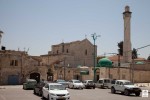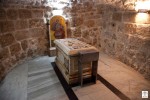Lod (Lydda)
(I Chronicles 8:12)
City on border of Judean Foothills and central Coastal Plain, with a rich history. North of Lod is Ben-Gurion International Airport.
History: First mentioned in City Lists of Egyptian King Thutmose III (15th c. BCE) as Rathan.
Mentioned in Bible as being built by Elpaal one of sons of Benjamin. According to Talmudic source, it was fortified in the days of Joshua, son of Nun. After Babylonian Exile it was settled by the tribe of Benjamin. A Jewish city during the Persian Period, it became an important center in the Hasmonean Period. After the destruction of the Second Temple, it was the seat of a small Sanhedrin and site of a large yeshiva headed by Rabbi Eliezer ben Hyrcanus, and staffed by Rabbi Tarfon, Rabbi Akiva, Rabbi Yehuda and many other sages.
After the Bar Kokhba revolt the Emperor Hadrian settled many pagans here; during the reign of Emperor Septimius Severus (193-211) the city was called Diospolis (city of god) and the Jews enjoyed a measure of tolerance. It seems that the local Jews participated in revolt against Gallus Caesar (Flavius Claudius Constantius who ruled Rome’s Eastern provinces – 351-354), and were punished when the revolt failed. During the Byzantine Period it was called Georgiopolis after St. George, who, according to Christian tradition, was buried here.
After the Arab conquest the city served as the capital of the province el Filastin, until Ramla was built (8th century). The Crusaders once again gave the city a Christian character and restored its Christian name – St. George. Rabbi Benjamin of Tudela mentions the name San George. When he visited, he found only one Jew here. In 1191 it was captured by Saladin and apparently the Jewish community then revived. Although the Mongol invaders destroyed Lod in 1271, Estori HaParhi found a Jewish community here in 14th century. During the Ottoman Period it was a small Moslem town with a few Christian espana-med.com. During the British Mandate it was a district center and railway junction.
Antiquities: Excavations at the local cattle market uncovered remains indicating habitation in the Late Stone Age, Chalcolithic Period and Early Bronze Age.
At another site, shards were found indicating occupation from the Middle Bronze Age until the Second Temple Period.
Other finds from later periods: 2 ancient mosques – one built on the ruins of a Byzantine and Crusader church; near the second mosque an inscription was found from 666 (Hegira) or 1268 CE; bathhouse and khan from the Middle Ages; ancient sheikh’s tomb and a church built partially on remains of a 12th-century Crusader church and in whose basement is the tomb of St. George.




